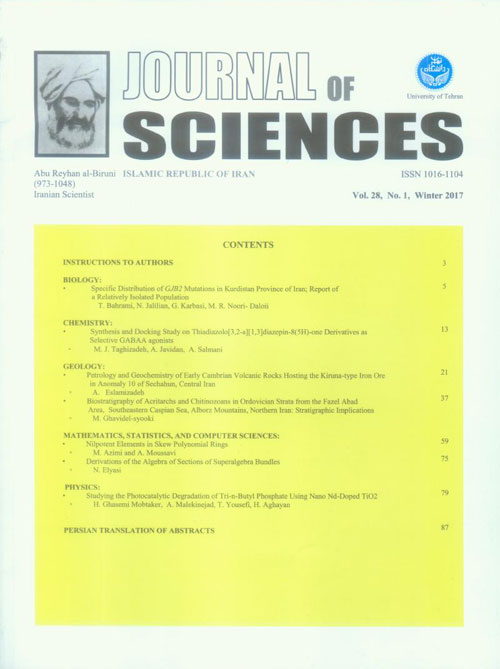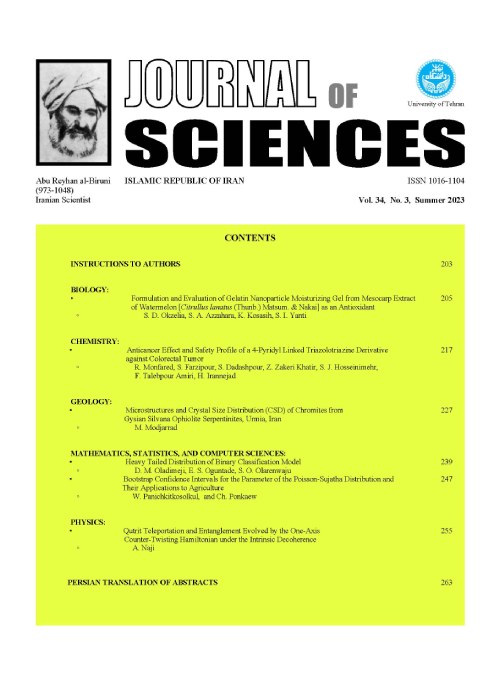فهرست مطالب

Journal of Sciences, Islamic Republic of Iran
Volume:28 Issue: 1, Winter 2017
- 98 صفحه،
- تاریخ انتشار: 1395/11/01
- تعداد عناوین: 7
-
-
صفحات 59-74
-
صفحات 75-78
-
Pages 5-11Hearing Loss (HL) represents high genetic heterogeneity with an incidence of almost 1 out of 500 newborns in most populations. Approximately half of the cases have a genetic basis that most of them are autosomal recessive non-syndromic (ARNSHL) with DFNB1-related defect in many worldwide populations. Given the heterogeneity of the trait together with the unique infrastructure of Iranian population, made it necessary to study other loci than GJB2 in various ethnic groups in order to elucidate the genetic etiology of HL in Iran. The present study was designed to determine the contribution of four DFNB loci in Kurdistan Province, west Iran. In this connection, we performed GJB2 analysis and homozygosity mapping using STR markers covering the DFNB21, DFNB4 and DFNB7/11 loci in 20 pedigrees with ARNSHL. GJB2 mutations were the cause of HL in 20% of the patients. However, surprisingly, we only observed 35delG and IVS1>A mutation among the study population. We also did not find any family linked to DFNB21, DFNB4 and DFNB7/11. Our results indicate the contribution of other loci in etiology of HL in Kurdistan that needs to be carefully investigated.Keywords: ARNSHL, Iranian Kurdish people, GJB2, DFNBs
-
Pages 13-19HIE-124 is the new member of ultra-short acting hypnotics drug family. In this research, thiadiazole can act as the bio-isosteric replacement of thiazole in synthesized compounds as HIE-124 derivatives. HIE-124 drug, in which the heterocyclic thiazole ring replaced to thiadiazole, will be presented. Thiadiazolodiazepines were synthesized by a two-step reaction starting from the amino thiadiazole resulted from-various derivatives of benzoic acid and thiosemi-carbazide. In the first step, the reaction of synthetic raw material 2-amino thiadiazole and 4-chlorobutyrilchloride in toluene give the 4-chloro-N-(5-(methyl/aryl)-1,3,4-thiadiazol-2-yl)butanamide intermediate. In the next step, from the cyclization reaction of this intermediate ring in the presence of base under reflux, the target products are synthesized. Structure of products were identified based on IR, 1HNMR and 13CNMR spectroscopy analysis. The docking study of ligands were performed on the active site of GABAA that the common residues involved in allosteric modulators such as benzodiazepines and HIE-124 include ASN82, ASN81, PHE79, MET1, TYR106, ALA38 and AlA168. In the compounds 7a, 7c, 7d and 7e there is no any hydrogen bonding interaction, any π-π interactions and any π-cation interactions. According to the results the Kis (inhibition-constant) of all compounds 7a-7e with amount 67.59, 21.45, 43.7, 83.83, and 82.85 can inhibit the enzyme more efficiently compare to HIE-124 in which has 693.3 inhibition-constant. Based on the Docking calculations the new compounds might show better interaction between receptor (GABAA) than the HIE-124.Keywords: Thiopental Sodium, 4, Chloro, butyryl chloride, Thiosemi, carbazide, GABA A
-
Pages 21-35Early Cambrian volcanic rocks of the Posht-e Badam tectonic block in Central Iran which is hydrothermally altered to green color rocks, hosts the Kiruna-type Iron Oxide-Apatite (IOA) mineralization in Anomaly 10 of Sechahun deposit. Geochemically, these volcanic rocks are classified as high-potassium calc-alkaline and mainly consist of rhyolite and trachyandesite. These rocks are important for hosting the REE- bearing apatite-iron oxide ores. The rhyolitic tuffs with a likely common origin are associated with the volcanic rocks. In this research, a selection of samples from Anomaly 10 of Sechahun has been studied with respect to their geochemistry and petrography with a special focus on REE-bearing phases. The bulk geochemistry of the rock units was analyzed using (ICP-OES) and (ICP-MS) methods. The ore samples were studied using ore microscopy and scanning electron microscopy with the energy-dispersive X-ray spectroscopy (SEM-EDS) techniques. The results indicated that mineralization has occurred by magmatic differentiation, forming magnetite, hematite, and apatite, followed by hydrothermal reworking, forming minerals such as hematite ± actinolite. Dendritic forms of magnetite, and apatite are common in the area. Apatite grains with monazite inclusions are generally enriched in LREE. The similar distribution of trace elements in various types of volcanic rocks in Anomaly 10 indicates a co-genetic origin and possible petrogenetic relation of these rocks. The whole rocks have been derived from differentiation of a single magmatic source. This magma with a probable melasyenitic initial composition erupted in a rifting tectonic environment and experienced some partial melting of the crust.Keywords: Petrology, Geochemistry, Volcanic rocks, IOA, type, Sechahun
-
Pages 37-57Sixty-four surface samples from the Lower Palaeozoic rock units (mainly Lalun, Abastu and Abarsaj formations) near Kholin-Darreh village in the Fazel Abad area, southeastern the Caspian Sea, Northern Iran, were analyzed to determine their age relationships. The samples of Lalun Formation were barren, but those of Abastu and Abarsaj formations contained well-preserved and abundant palynomorph entities, which are dominated by acritarchs (23 species belonging to 15 genera) and chitinozoans (29 species distributing among 15 genera) with remains of scolecodonts, graptolite and a few cryptospores, although not determined in detail. Based on the restricted stratigraphic range of acritarch species, an Early Ordovician (Tremadocian) age was assigned to the Abastu Formation; while based upon index chitinozoan and acritarch taxa, a Late Ordovician (Katian to Hirnantian) age was assigned to the Abarsaj Formation. Likewise, based on the presence of diagnostic chitinozoan taxa, the Abarsaj Formation can be assigned to the Armoricochitina nigerica, Ancyrochitina merga, Tanuchitina elongata and Spinachitina oulebsiri chitinozoan Biozones. These chitinozoan assemblages reflect a clear palaeobiogeographic affinity with the so-called "North Gondwana Domain". Two major hiata are present within the studied Lower Palaeozoic succession in the Fazel Abad area. The first hiatus appeared between the Lalun Formation (Early Cambrian) and the Abastu Formation (Tremadocian) and includes the Middle-Upper Cambrian Mila Formation. The second hiatus occurs between the Abastu Formation (Tremadocian) and the Abarsaj Formation (Katian-Hirnantian) and spans the interval of the Floian- Sandbian, which corresponds to uplift related to the initial stage of rifting of the Palaeo- Tethys Ocean.Keywords: Acritarchs, chitinozoans, Biostratigraphy, Gondwana, southeastern Caspian Sea
-
Pages 59-74Letbe a ring with an endomorphism and an -derivationAntoine studied the structure of the set of nilpotent elements in Armendariz rings and introduced nil-Armendariz rings. In this paper we introduce and investigate the notion of nil--compatible rings. The class of nil--compatible rings are extended through various ring extensions and many classes of nil--compatible rings are constructed. We also prove that, if is nil--compatible and nil-Armendariz ring of power series type with nilpotent, then . We show that, if is a nil-Armendariz ring of power series type, with nilpotent and nil--compatible ring, then As a consequence, several known results are unified and extended to the more general setting. Also examples are provided to illustrate our results.Keywords: compatible ring, skew polynomial ring, skew power series ring
-
Pages 75-78In this paper we review the concepts of the superalgebra, superderivation and some properties of them. We will define algebraic and differential superderivations on a superalgebra and will prove some theorems about them, Then we consider a superalgebra bundle, that is an algebra bundle which its fibers are superalgebras and then characterize the superderivations of the algebra of sections of that bundle.Keywords: Superalgebra, Superderivation, Algebraic superderivation, Differential superderivation
-
Pages 79-85Photocatalytic method was used as an efficient and simple way for degradation of tri-n-butyl phosphate (TBP). In contrast to other methods, in this method the mineralization occurs and no twin pollution is generated. Nd doped TiO2 was synthesized via sol gel process and characterized by XRD and TEM tecniuqes. Then it was used as photocatalyst for TBP degradetion. It was found that the solution pH has important effect on degradation efficiency and kinetic. Degradation was more efficient in both acidic and alkali media. The kinetic studies indicated that the second order model at neutral pHs range was the dominant while in acidic or alkali conditions the kinetic models were first and third order respectively. By proceeding the degradation process, some products and byproducts are generated, which lead to the change of the solution pH and change of degradetion mechanism and kinetic. The LC MS was used to detect the intermediate and final products. Results showed that the method has high efficiency and is a promising procedure for decomposition of TBP.Keywords: TBP, Photodegradation, TiO2


